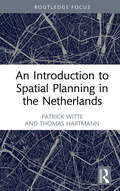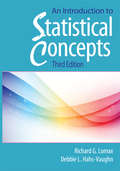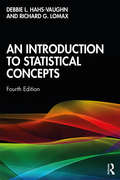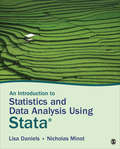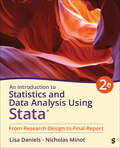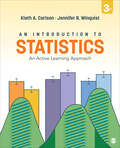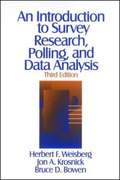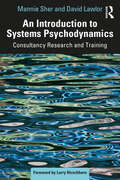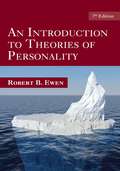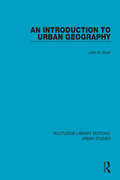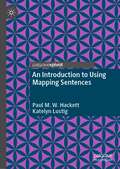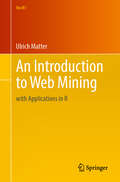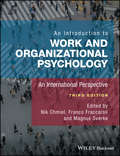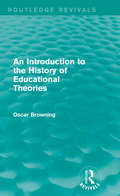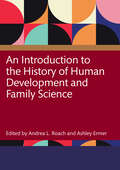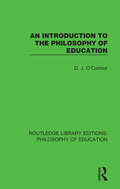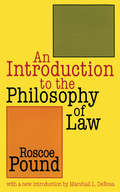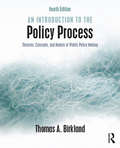- Table View
- List View
An Introduction to Sociology: Feminist Perspectives
by Pamela Abbott Claire Wallace Melissa TylerThis third edition of this best-selling book confirms the ongoing centrality of feminist perspectives and research to the sociological enterprise, and introduces students to the wide range of feminist contributions in key areas of sociological concern. Completely revised, this edition includes: new chapters on sexuality and the media additional material on race and ethnicity, disability and the body many new international and comparative examples the influence of theories of globalization and post-colonial studies. In addition, the theoretical elements have also been fully rethought in light of recent developments in social theory. Written by three experienced teachers and examiners, this book gives students of sociology and women's studies an accessible overview of the feminist contribution to all the key areas of sociological concern.
An Introduction to Spatial Planning in the Netherlands
by Thomas Hartmann Patrick WitteThis book provides an introduction to spatial planning in the Netherlands. It explores the academic underpinnings of the discipline and its practical implications, making use of insights on planning practices from the Netherlands. As an academic book with relevance for spatial planning teaching and practice, the relation between planning practice and planning as an academic discipline are discussed. A key analytical concept is introduced to discuss the different dimensions of planning: the planning triangle. This framework helps to bridging the strategic and conceptual elements of planning with its realization. The object, process and context of planning and its relations are discussed. The core of the academic discipline and profession of spatial planning entails looking (far) into the future, stimulating discussion, formulating a desired future direction through an informal and collective planning process and then formalizing and placing current action into that future perspective. In that sense, spatial planning can be understood as the strategic organisation of hopes and expectations. As a study book it is suitable for students of planning at various universities, but also for students in higher professional education. For those involved in the professional field of spatial planning, this book offers a sound foundation.
An Introduction to Statistical Concepts: Third Edition
by Debbie L. Hahs-Vaughn Richard G. LomaxThis comprehensive, flexible text is used in both one- and two-semester courses to review introductory through intermediate statistics. Instructors select the topics that are most appropriate for their course. Its conceptual approach helps students more easily understand the concepts and interpret SPSS and research results. Key concepts are simply stated and occasionally reintroduced and related to one another for reinforcement. Numerous examples demonstrate their relevance. This edition features more explanation to increase understanding of the concepts. Only crucial equations are included.In addition to updating throughout, the new edition features: New co-author, Debbie L. Hahs-Vaughn, the 2007 recipient of the University of Central Florida's College of Education Excellence in Graduate Teaching Award. A new chapter on logistic regression models for today's more complex methodologies. More on computing confidence intervals and conducting power analyses using G*Power. Many more SPSS screenshots to assist with understanding how to navigate SPSS and annotated SPSS output to assist in the interpretation of results. Extended sections on how to write-up statistical results in APA format. New learning tools including chapter-opening vignettes, outlines, and a list of key concepts, many more examples, tables, and figures, boxes, and chapter summaries. More tables of assumptions and the effects of their violation including how to test them in SPSS. 33% new conceptual, computational, and all new interpretative problems. A website that features PowerPoint slides, answers to the even-numbered problems, and test items for instructors, and for students the chapter outlines, key concepts, and datasets that can be used in SPSS and other packages, and more. Each chapter begins with an outline, a list of key concepts, and a vignette related to those concepts. Realistic examples from education and the behavioral sciences illustrate those concepts. Each example examines the procedures and assumptions and provides instructions for how to run SPSS, including annotated output, and tips to develop an APA style write-up. Useful tables of assumptions and the effects of their violation are included, along with how to test assumptions in SPSS. 'Stop and Think' boxes provide helpful tips for better understanding the concepts. Each chapter includes computational, conceptual, and interpretive problems. The data sets used in the examples and problems are provided on the web. Answers to the odd-numbered problems are given in the book. The first five chapters review descriptive statistics including ways of representing data graphically, statistical measures, the normal distribution, and probability and sampling. The remainder of the text covers inferential statistics involving means, proportions, variances, and correlations, basic and advanced analysis of variance and regression models. Topics not dealt with in other texts such as robust methods, multiple comparison and nonparametric procedures, and advanced ANOVA and multiple and logistic regression models are also reviewed.Intended for one- or two-semester courses in statistics taught in education and/or the behavioral sciences at the graduate and/or advanced undergraduate level, knowledge of statistics is not a prerequisite. A rudimentary knowledge of algebra is required.
An Introduction to Statistical Concepts: Third Edition
by Richard G. Lomax Debbie L. Hahs-VaughnThe new edition of An Introduction to Statistical Concepts, is designed to help students really understand statistical concepts, the situations in which they can be used, and how to apply them to data. Hahs-Vaughn and Lomax discuss the most popular, along with many of the lesser-known, procedures and models, whilst also exploring nonparametric procedures used when standard assumptions are violated. They provide in-depth coverage of testing assumptions and highlight several online tools for computing statistics (e.g., effect sizes and their confidence intervals and power). This comprehensive, flexible and accessible text includes a new chapter on mediation and moderation; expanded coverage of effect sizes; discussions of sensitivity, specificity, false positive, and false negative, along with using the receiver operator characteristic (ROC) curve. This book, noted for its crystal-clear explanations, and its inclusion of only the most crucial equations, is an invaluable resource for students undertaking a course in statistics in any number of social science and behavioral disciplines—from education, business, communication, exercise science, psychology, sociology and more.
An Introduction to Statistics and Data Analysis Using Stata®: From Research Design to Final Report
by Lisa Daniels Nicholas W. MinotAn Introduction to Statistics and Data Analysis Using Stata® by Lisa Daniels and Nicholas Minot provides a step-by-step introduction for statistics, data analysis, or research methods classes with Stata. Concise descriptions emphasize the concepts behind statistics for students rather than the derivations of the formulas. With real-world examples from a variety of disciplines and extensive detail on the commands in Stata, this text provides an integrated approach to research design, statistical analysis, and report writing for social science students.
An Introduction to Statistics and Data Analysis Using Stata®: From Research Design to Final Report
by Lisa Daniels Nicholas W. MinotAn Introduction to Statistics and Data Analysis Using Stata® by Lisa Daniels and Nicholas Minot provides a step-by-step introduction for statistics, data analysis, or research methods classes with Stata. Concise descriptions emphasize the concepts behind statistics for students rather than the derivations of the formulas. With real-world examples from a variety of disciplines and extensive detail on the commands in Stata, this text provides an integrated approach to research design, statistical analysis, and report writing for social science students.
An Introduction to Statistics and Data Analysis Using Stata®: From Research Design to Final Report
by Lisa Daniels Nicholas W. MinotAn Introduction to Statistics and Data Analysis Using Stata®: From Research Design to Final Report, Second Edition provides an integrated approach to research methods, statistics and data analysis, and interpretation of results in Stata. Drawing on their combined 25 years of experience teaching statistics and research methods, authors Lisa Daniels and Nicholas Minot frame data analysis within the research process—identifying gaps in the literature, examining the theory, developing research questions, designing a questionnaire or using secondary data, analyzing the data, and writing a research paper—so readers better understand the context of data analysis. Throughout, the text focuses on documenting and communicating results so students can produce a finished report or article by the end of their courses. The Second Edition has been thoroughly updated with all new articles and data—including coverage of ChatGPT, COVID-19 policies, and SAT scores—to demonstrate the relevance of data analysis for students. A new chapter on advanced methods in regression analysis allows instructors to better feature these important techniques. Stata code has been updated to the latest version, and new exercises throughout offer more chances for practice.
An Introduction to Statistics and Data Analysis Using Stata®: From Research Design to Final Report
by Lisa Daniels Nicholas W. MinotAn Introduction to Statistics and Data Analysis Using Stata®: From Research Design to Final Report, Second Edition provides an integrated approach to research methods, statistics and data analysis, and interpretation of results in Stata. Drawing on their combined 25 years of experience teaching statistics and research methods, authors Lisa Daniels and Nicholas Minot frame data analysis within the research process—identifying gaps in the literature, examining the theory, developing research questions, designing a questionnaire or using secondary data, analyzing the data, and writing a research paper—so readers better understand the context of data analysis. Throughout, the text focuses on documenting and communicating results so students can produce a finished report or article by the end of their courses. The Second Edition has been thoroughly updated with all new articles and data—including coverage of ChatGPT, COVID-19 policies, and SAT scores—to demonstrate the relevance of data analysis for students. A new chapter on advanced methods in regression analysis allows instructors to better feature these important techniques. Stata code has been updated to the latest version, and new exercises throughout offer more chances for practice.
An Introduction to Statistics: An Active Learning Approach
by Jennifer R. Winquist Kieth Alton CarlsonThis updated and reorganized Third Edition of this textbook takes a workbook-style approach that encourages an active approach to learning statistics. Carefully placed reading questions throughout each chapter allow students to apply their knowledge right away, while in-depth activities based on current behavioral science scenarios, each with problem sets and quiz questions, give students the opportunity to assess their understanding of concepts while reading detailed explanations of more complex statistical concepts. Additional practice problems further solidify student learning. Most activities are self-correcting, so if a concept is misunderstood, this misunderstanding is corrected early in the learning process. After working through each chapter, students are far more likely to understand the material than when they only read the material.
An Introduction to Statistics: An Active Learning Approach
by Jennifer R. Winquist Kieth Alton CarlsonThis updated and reorganized Third Edition of this textbook takes a workbook-style approach that encourages an active approach to learning statistics. Carefully placed reading questions throughout each chapter allow students to apply their knowledge right away, while in-depth activities based on current behavioral science scenarios, each with problem sets and quiz questions, give students the opportunity to assess their understanding of concepts while reading detailed explanations of more complex statistical concepts. Additional practice problems further solidify student learning. Most activities are self-correcting, so if a concept is misunderstood, this misunderstanding is corrected early in the learning process. After working through each chapter, students are far more likely to understand the material than when they only read the material.
An Introduction to Survey Research, Polling, and Data Analysis (3rd edition)
by Herbert F. Weisberg Jon A. Krosnick Bruce D. BowenExplains how surveys are conducted, how to read statistical reports, and how to analyze data, and provides guidelines for evaluating polls. Coverage includes understanding tables, interval statistics, survey design, sampling and question-writing, interviewing and coding strategies, analysis of different types of surveys, and reading and writing reports. Includes chapter exercises and answers. Paper edition (unseen), $25. 95. Annotation c. by Book News, Inc. , Portland, Or.
An Introduction to Systems Psychodynamics: Consultancy Research and Training
by Mannie Sher David LawlorThis book provides an introduction to systems psychodynamic theory and its application to organisational consultancy, research and training, outlining systems dynamics methods and their historical and theoretical developments. Systems Psychodynamics is an emerging field of social science, the boundaries of which are continually being refined and re-defined. The ‘systems’ designation refers to open systems concepts that provide the framing perspective for understanding the structural aspects of organisational systems. These include its design, division of labour, levels of authority, and reporting relationships; the nature of work tasks, processes, and activities; its mission and primary task; and the nature and patterning of the organisation’s task and sentient boundaries and the transactions across them. This book presents a critical appraisal of the systems psychodynamics paradigm and its application to present-day social and organisational difficulties, showing how a holistic approach to organisational and social problems can offer a fresh perspective on difficult issues. Bringing together the theory and practice of systems psychodynamics for the first time, this book provides an examination of the systems psychodynamics paradigm in action. This book gives an accessible and thorough guide to understanding and using systems psychodynamic ideas for analysts, managers, policy makers, consultants and researchers in a wide range of professional and clinical settings.
An Introduction to Theories of Personality: 7th Edition
by Robert B. Ewen Robert Ewen BThis 7th Edition helps students unravel the mysteries of human behavior through its highly readable introduction to the ideas of the most significant personality theorists. Engaging biographical sketches begin each chapter, and unique capsule summaries help students review key concepts. Theories come alive through the inclusion of quotations from the theorists’ writings and numerous applications such as dream interpretation, psychopathology, and psychotherapy. Significant changes in the 7th edition include an extended discussion of the practical applications of personality theory, with an emphasis on guidelines that can help people increase their self-knowledge, make better decisions, and live more fulfilling lives. Fictionalized but true-to-life examples illustrating the perils of inadequate self-knowledge include college students, parents, terrorists, business executives, and politicians, while other examples show the positive outcomes that can result from a better understanding of one’s unconscious. This 7th edition also includes a more extensive discussion of how a lack of self-understanding caused difficulties for such noted theorists as Freud and Erikson, and a new section that explains how behavior can be strongly influenced by the situation as well as by one’s personality. Finally, a new interactive web site provides practice test questions and other topics of interest.
An Introduction to Universal Artificial Intelligence (Chapman & Hall/CRC Artificial Intelligence and Robotics Series)
by Marcus Hutter David Quarel Elliot CattAn Introduction to Universal Artificial Intelligence provides the formal underpinning of what it means for an agent to act intelligently in an unknown environment. First presented in Universal Algorithmic Intelligence (Hutter, 2000), UAI offers a framework in which virtually all AI problems can be formulated, and a theory of how to solve them. UAI unifies ideas from sequential decision theory, Bayesian inference, and algorithmic information theory to construct AIXI, an optimal reinforcement learning agent that learns to act optimally in unknown environments. AIXI is the theoretical gold standard for intelligent behavior.The book covers both the theoretical and practical aspects of UAI. Bayesian updating can be done efficiently with context tree weighting, and planning can be approximated by sampling with Monte Carlo tree search. It provides algorithms for the reader to implement, and experimental results to compare against. These algorithms are used to approximate AIXI. The book ends with a philosophical discussion of Artificial General Intelligence: Can super-intelligent agents even be constructed? Is it inevitable that they will be constructed, and what are the potential consequences?This text is suitable for late undergraduate students. It provides an extensive chapter to fill in the required mathematics, probability, information, and computability theory background.
An Introduction to Urban Geography (Routledge Library Editions: Urban Studies #22)
by John R. ShortThis book, first published in 1984, is an attempt to make students aware of the variety in the urban condition and to introduce them to some of the relationships operating between space and society. From the broad aim of seeking to show the relationship between urbanism and society flows a number of sub-themes, including the importance of cross-cultural comparisons and contrasts, re-distributional consequences and the role of government. This book will be of interest to first- and second-year students of urban studies and human geography.
An Introduction to Using Mapping Sentences
by Paul M. Hackett Katelyn LustigThis book acts as an introductory guide to understanding and using the mapping sentence as a tool in social science and humanities research. The book fills the need for a concise text that simply instructs how and when to use a mapping sentence and provides practical examples. Mapping sentences are a major research component and tool of facet theory. The book begins by covering the background to mapping sentence, including the philosophy and theory underpinning it. The following chapter discuss what mapping sentence is, what different kinds of mapping sentences exist, and knowing when and which to use it in a given situation. The book then moves into describing how to write a mapping sentence and how to analyse the information gained from mapping sentence research. It ends with a consideration of the future developments of mapping sentences and their applications across the social sciences and humanities, including in particular psychology, marketing, behavioural biology, art and health.
An Introduction to W. E. B. Du Bois
by Earl Wright II Kalasia S. OjehAn Introduction to W. E. B. Du Bois examines the historical contributions to social science and the continuing relevance of the work of W. E. B. Du Bois in an accessible manner. The first volume of its kind, it places the theories of Du Bois in context, showing how the socio‑racial environment in which he grew up and came of age influenced the development of his thought. In addition to covering well‑known concepts such as double consciousness, the veil, and religious fatalism, the authors discuss Du Bois’ uncoined theories emanating from the Atlanta University Studies, as well as his contributions to the development of Black sociology and research methodology. A groundbreaking contextualization and summary of the importance of Du Bois’ work to sociology and sociological theory, this book constitutes a much‑needed resource for scholars and students seeking to understand this scholar’s significance to the social sciences beyond the elementary level.
An Introduction to Web Mining: with Applications in R (Use R!)
by Ulrich MatterThis book is devoted to the art and science of web mining — showing how the world's largest information source can be turned into structured, research-ready data. Drawing on many years of teaching graduate courses on Web Mining and on numerous large-scale research projects in web mining contexts, the author provides clear explanations of key web technologies combined with hands-on R tutorials that work in the real world — and keep working as the web evolves. Through the book, readers will learn how to - scrape static and dynamic/JavaScript-heavy websites - use web APIs for structured data extraction from web sources - build fault-tolerant crawlers and cloud-based scraping pipelines - navigate CAPTCHAs, rate limits, and authentication hurdles - integrate AI-driven tools to speed up every stage of the workflow - apply ethical, legal, and scientific guidelines to their web mining activities Part I explains why web data matters and leads the reader through a first &“hello-scrape&” in R while introducing HTML, HTTP, and CSS. Part II explores how the modern web works and shows, step by step, how to move from scraping static pages to collecting data from APIs and JavaScript-driven sites. Part III focuses on scaling up: building reliable crawlers, dealing with log-ins and CAPTCHAs, using cloud resources, and adding AI helpers. Part IV looks at ethical, legal, and research standards, offering checklists and case studies, enabling the reader to make responsible choices. Together, these parts give a clear path from small experiments to large-scale projects. This valuable guide is written for a wide readership — from graduate students taking their first steps in data science to seasoned researchers and analysts in economics, social science, business, and public policy. It will be a lasting reference for anyone with an interest in extracting insight from the web — whether working in academia, industry, or the public sector.
An Introduction to Work and Organizational Psychology: An International Perspective
by Franco Fraccaroli Magnus Sverke Nik ChmielThis fully updated edition of a best-selling textbook provides the most comprehensive introduction to issues in work and organizational psychology with an international perspective; reflecting current advancements in the workplace, the book brings together the expertise of leading thinkers and practitioners. Fully updated third edition of the best-selling textbook on work and organizational psychology now with an international perspective Presents a solid foundation on a range of core topics including working with technology, the impact on employees when organizations change, and maintaining the work-life balance Updated throughout to include recently emerging themes and current views in the field Includes five new case studies covering age management, diversity at the top, resilience development, respect at work and a strategic approach to improving wellbeing in the workplace Provides instructor and student support includes key studies, research close-ups, discussion points and five extensive case studies
An Introduction to the Geography of Health
by Peter Anthamatten Helen HazenIn the second edition of An Introduction to the Geography of Health, Hazen and Anthamatten explore the ways in which geographic ideas and approaches can inform our understanding of health. The book’s focus on a broad range of physical and social factors that drive health in places and spaces offers students and scholars an important holistic perspective on the study of health in the modern era. In this edition, the authors have restructured the book to emphasize the theoretical significance of ecological and social approaches to health. Spatial methods are now reinforced throughout the book and other qualitative and quantitative methods are discussed in greater depth. Data and examples are used extensively to illustrate key points and have been updated throughout, including several new extended case studies such as water contamination in Flint Michigan, microplastics pollution, West Africa’s Ebola crisis, and the Zika epidemic. The book contains over one hundred figures, including new and updated maps, data graphics, and photos. The book is designed to be used as the core text for a health geography course for undergraduate and lower-level graduate students, and is relevant to students of biology, medicine, entomology, social science, urban planning, and public health.
An Introduction to the History of Educational Theories (Routledge Revivals)
by Oscar BrowningAn Introduction to the History of Educational Theories, first published in 1881, offers a comprehensive overview of the most notable approaches to education throughout Western history, from Athens and Rome to the Victorian public school. Exploring not only the still famous theories of Plato and Aristotle, this work also touches on techniques in education which are either no longer prevalent – Roman Oratory, the Jesuits – or in some cases were never widely adopted or appreciated: John Milton, for example. This title will be of value to those intrigued by the potential of past attitudes for present-day application, as well as to those unconvinced by contemporary approaches.
An Introduction to the History of Human Development and Family Science
by Andrea L. RoachThis comprehensive textbook offers an interdisciplinary introduction to the history of human development and family science. It provides insights from home economics, sociology and psychology to explain and analyze how the field was established and how it is developing and showcases the contribution of its unique transdisciplinary nature.Expert authors cover key topics and highlight historical contributions from women, scholars of color and LGBTQIA scholars; they emphasize and incorporate research that cuts across cultures; and examine current human development and family science trends in research and careers in their chosen fields. Subjects and issues covered include historical and contemporary studies of child development, adolescent development and young adulthood, adulthood and aging, family science, marriage formation and maintenance, parenthood, divorce, the role of grandparents and sibling relationships.Exploring how human development and family science can be used as a springboard into careers such as marriage and family therapy, social work, case management, teaching and research, this essential textbook is for all students of human development and family science.
An Introduction to the Philosophy of Education (Routledge Library Editions: Philosophy of Education #14)
by D. J. O'ConnorEducation, like every other important branch of knowledge, has its underlying philosophical problems. It is these problems and the attempts to solve them which together make up the philosophy of education. This book, first published in 1957, provides a simple explanation and illustration of what philosophy can (and cannot) do for educational thinking. This title will be of interest to students of the philosophy of education.
An Introduction to the Philosophy of Law (Storrs Lecture)
by Roscoe Pound Marshall. L DeRosaIn An Introduction to the Philosophy of Law, Roscoe Pound shows how philosophy has been a powerful instrument throughout the history of law. He examines what philosophy has done for some of the chief problems of the science of law and how it is possible to look at those problems philosophically without treating them in terms of a particular time period. The function of legal philosophy, writes Pound, is to rationally formulate a general theory of law which conforms to the interests, the general security first and foremost, of society. Marshall DeRosa writes in his new introduction that in the light of twentieth-century judicial politics, Roscoe Pound's philosophy of law has prevailed to a significant extent. This book's relevance to appreciating the development of the American legal system in all its complexities - including liability law, contract law, and property law - is in itself notable. But, in terms of understanding the twentieth-century development of the American rule of law, An Introduction to the Philosophy of Law is indispensable. It will make an invaluable addition to the personal libraries of legal theorists, philosophers, political scientists, and historians of American law.
An Introduction to the Policy Process
by Thomas A BirklandThe fourth edition of this widely-used text relates theory to practice in the public policy process. In a clear, conversational style, author Tom Birkland conveys the best current thinking on the policy process with an emphasis on accessibility and synthesis. This new edition has been reorganized to better explain the role of policy analysis in the policy process. New to this edition: * A new section on the role of policy analysis and policy analysts in the policy process. * A revised and updated chapter surveying the social, economic, and demographic trends that are transforming the policy environment. * Fully updated references to help the advanced reader locate the most important theoretical literature in policy process studies. * New illustrations and an improved layout to clarify key ideas and stimulate classroom discussion. The book makes generous use of visual aids and examples that link policy theory to the concrete experience of practitioners. It includes chapter-at-a-glance outlines, definitions of key terms, provocative review questions, recommended reading, and online materials for professors and students.

